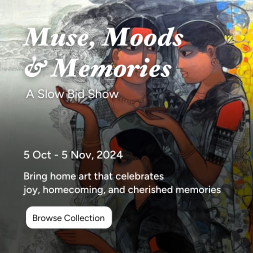-
Loading...
-
Loading...
-
Loading...Horses 2 by M.F Husain 400000 (Incl of GST)
By M.F. Husain
horse | Serigraph | Serigraph 40 (w) x 60 (h) inches
-
Loading...
-
Loading...Rythmic Monsoon Ride 28000 (Incl of GST)
horse | Painting | Acrylic Charcoal on Canvas | 24 (w) x 12 (h) inches
-
Loading...The Grace of Blue Horses 403200 (Incl of GST)
By H R Das
horse | Painting | Acrylic on Canvas | 48 (w) x 36 (h) inches
-
Loading...Kolkata the City of Joy - III 14500 (Incl of GST)
By Ananda Das
horse | Painting | Acrylic on Canvas | 12 (w) x 12 (h) inches
-
Loading...Yesteryears of Pune 50400 (Incl of GST)
horse | Painting | Acrylic on Canvas | 24 (w) x 36 (h) inches
-
Loading...Loading...Challenging the Speed 50400 (Incl of GST)
By Ananda Das
horse | Painting | Charcoal on Paperboard | 36 (w) x 36 (h) inches
Loading...The Shadowy Horses 50400 (Incl of GST)By Ananda Das
horse | Painting | Charcoal on Paperboard | 39 (w) x 33 (h) inches
Loading...Beauty and Power 161300 (Incl of GST)By Ramesh Gujar
horse | Painting | Acrylic on Canvas | 48 (w) x 36 (h) inches
- Home
- >
- Collections
- >
- Horse Paintings
Horse Paintings
Horse paintings have long captured the imagination of artists and viewers alike, symbolizing power, grace, freedom, and beauty. This timeless subject transcends cultural boundaries, finding its place in both Western and Indian art traditions, each bringing unique perspectives and techniques to the portrayal of these magnificent creatures.
The enduring popularity of horse paintings across cultures can be attributed to the universal admiration for the horse's beauty, strength, and symbolic significance. In both Western and Indian art, horses are more than mere subjects; they are embodiments of cultural values and human emotions. The versatility of the horse as a symbol allows artists to explore a wide range of themes, from nobility and freedom to power and grace.
Horse paintings are created in various styles ranging from realism to impressionism, expressionism to cubism. Contemporary artists such as Aditya Shirke...
Read More
Horse paintings have long captured the imagination of artists and viewers alike, symbolizing power, grace, freedom, and beauty. This timeless subject transcends cultural boundaries, finding its place in both Western and Indian art traditions, each bringing unique perspectives and techniques to the portrayal of these magnificent creatures.
The enduring popularity of horse paintings across cultures can be attributed to the universal admiration for the horse's beauty, strength, and symbolic significance. In both Western and Indian art, horses are more than mere subjects; they are embodiments of cultural values and human emotions. The versatility of the horse as a symbol allows artists to explore a wide range of themes, from nobility and freedom to power and grace.
Horse paintings are created in various styles ranging from realism to impressionism, expressionism to cubism. Contemporary artists such as Aditya Shirke and Dinkar Jadhav have depicted horses with an Indian aesthetic. M.F. Hussain's cubist horses leaping off the canvas have become iconic in modern Indian art. Today, numerous artists explore this theme with their own unique perspectives, using a variety of mediums such as watercolor, charcoal, acrylic, and oil.
You can also discover our collection of animal paintings, including bull paintings, for more art inspired by the animal kingdom..
Can we help you with Finding your favorite piece of art? Reach out to us by clicking below.

Reach out to Artflute's Curators
Hello there! It's lovely to see that you are exploing art. Please fill in these details to help us find the perfect piece of art for you.
Other collections you may like
FAQs for Horse paintings
A horse painting, also known as an equine portrait or equestrian art, is the depiction of horses in any medium from oil paint to watercolor to acrylics. Horse paintings depict horses at rest, working, running, jumping, galloping, dancing, standing still, eating hay, drinking water, grooming themselves, etc. The subject matter may be realistic or abstract.
There are several things you should look for when buying a horse painting. First, make sure that it's done by a professional artist. If you're looking at a piece online, check out the Artflute.com website. You may want to read more about the artist to get more information. Second, look for quality. Make sure that the colors are vibrant and bright. Third, look at the composition. Does the artist use perspective correctly?
The power of a majestic horse and its beautiful movement instill a sense of inspiration and energy. The paintings of this courageous, confident and independent animal invigorates the atmosphere of any living room.
Horse paintings are usually painted using oils, acrylics, pastels, charcoal, pencil crayons, graphite, ink, colored pencils, gouache, watercolors, tempera paints, etc.
The Limited Edition prints on Artflute.com start at Rs 3,500 while original Abstract Paintings start from around Rs 20,000 and upwards. The price depends on the size of the canvas, the complexity of the design, the number of horses depicted, the materials used, etc.
Horse paintings by famous artists
Whether depicted in the refined, detailed style of George Stubbs or the vibrant, opulent manner of Mughal miniatures, horse paintings continue to captivate audiences worldwide. Their timeless appeal lies in their ability to connect viewers with a sense of beauty, history, and the enduring bond between humans and these majestic animals.
In Indian art, horses have been depicted since the time of ancient cave paintings, symbolizing valor, royalty, and spirituality. The Mughal era brought a refined aesthetic to horse painting, with artists like Ustad Mansur creating detailed and vibrant depictions of royal steeds. These works often showcased the horse in elaborate, colorful settings, reflecting the grandeur and opulence of the Mughal courts.
Rajasthani miniature paintings also frequently feature horses, particularly in scenes of royal processions and battles. These intricate works emphasize the horse's association with royalty and martial prowess, often depicted in vibrant hues and detailed ornamentation. The Marwar school of painting, for example, is known for its dynamic depictions of horse-mounted warriors and kings.
In contemporary Indian art, horses continue to be a popular subject, symbolizing freedom and strength. Artists like M F Husain have used the horse motif to explore themes of energy and movement, blending traditional and modern techniques to create powerful and expressive works.
In Western art, horses have been a prominent subject since ancient times. The Renaissance era saw artists like Leonardo da Vinci and Albrecht Dürer meticulously study and depict horses, emphasizing their anatomical perfection and dynamic movement. The 18th and 19th centuries brought an explosion of equine art, with artists such as George Stubbs and Edgar Degas elevating horse paintings to new heights. Stubbs, often called the "father of equine painting," is renowned for his detailed and lifelike representations, capturing the nobility and strength of horses. Degas, on the other hand, depicted horses in motion, particularly in racecourse scenes, highlighting their elegance and speed.
The Western tradition often focuses on the horse's role in human endeavors—be it in war, sport, or daily labor. This is evident in works like Jacques-Louis David's "Napoleon Crossing the Alps," where the horse symbolizes heroism and grandeur, or in the dynamic racehorses of Degas, which capture the excitement and energy of the racetrack.
Horse Abstract Paintings
The dynamic movements, grace, and flow of horses naturally lead to abstract and semi-abstract interpretations. M F Husain was renowned for his cubist style horse paintings that can almost be described as abstract in style. While an original Husain artwork is out of reach for most of us, we do have limited edition serigraphs of M. F. Husain that include his famous horse series of paintings. Each individual serigraph is numbered as per the edition number and hand signed by Husain himself.

Scan to Chat with us
Address:
PixMyWall Art Private Limited
The Executive Centre India
Kaman Amaryllis, Embassy Golf Link Road, Bengaluru – 560071
GST: 29AAGCP9708H1ZY


 Price
Price
 Size
Size

 Orientation
Orientation
 Color
Color
 Style
Style
 Categories
Categories
 Sort
Sort











 '
'
 '
'
 '
'
 '
'

